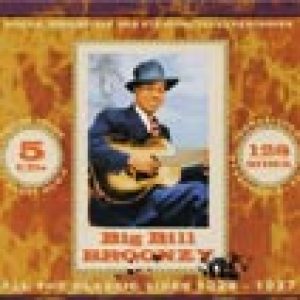calsfoundation@cals.org
"Big Bill" Broonzy (1893?–1958)
aka: William Conley Lee Broonzy
Although William Lee Conley “Big Bill” Broonzy achieved fame and success in the Chicago blues scene and the folk revival in the United States and abroad, some of his earliest encounters with the blues and his earliest experiences as a performer and songwriter were in Arkansas.
Sources differ as to the date and place of Big Bill Broonzy’s birth. Broonzy himself claimed to have been born in Scott, Mississippi, on June 26, 1893 (though some sources say 1898). However, more recent research has him born near Lake Dick, Arkansas, on June 29, 1903, with the name Lee Conley Bradley. His parents were Frank Broonzy (Bradley) and Mittie Belcher, and he was one of seventeen children. Broonzy spent most of his childhood years in the Pine Bluff (Jefferson County) area. He began performing music at an early age, playing for social and church events on the fiddle, which he learned from his uncle, Jerry Belcher. In addition to odd jobs as a musician, Broonzy also served briefly as a pastor in the Pine Bluff area before 1918.
Between the years 1917 and 1919, Broonzy served in the U.S. Army and was stationed in Europe. After his discharge in 1919, Broonzy returned to Arkansas for a brief time, playing in clubs around the Little Rock (Pulaski County) and Pine Bluff areas. In the early 1920s, Broonzy moved to Chicago, Illinois, where he switched instruments to the guitar, taught to him by Papa Charlie Jackson, and began a prolific recording career under the Paramount, Columbia, Bluebird, Okeh, and Chess record labels. Examples of his recording career can be found on numerous compilations. The most comprehensive collection is the twelve-volume anthology of the complete works of Big Bill Broonzy, which was produced by Document Records beginning in 1994.
Influenced by musicians such as Jimmie Rodgers, Blind Blake, Son House, and Blind Lemon Jefferson, Broonzy developed an amalgamated form of the blues. By combining ragtime and hokum blues with country blues, he created a style that foreshadowed the post–World War II Chicago sound, which was later defined by such artists as Muddy Waters and Willie Dixon.
In 1938, Broonzy filled in for Robert Johnson, who had died unexpectedly, at the Spirituals to Swing Concert produced by John Hammond at Carnegie Hall. The fame achieved from this event and a follow-up concert in 1939 established Broonzy as a key figure in the Chicago blues scene. While in Chicago, Broonzy recorded more than 300 songs and remained a popular and well-respected artist throughout the 1940s. His prolific musical output is evident from his fruitful solo career and his collaborations with other artists, such as singer/guitarist Brownie McGhee.
With the rise of electric blues in the early 1950s, Broonzy became an active supporter of the folk blues genre. In 1951, Broonzy took his first tour of Europe, where he was met with enthusiasm and appreciation. His appearances in Europe introduced the blues to European audiences and were especially influential in London’s emerging skiffle and rock blues scene. Broonzy’s success also set the stage for later blues artists such as Sonny Boy Williamson II and Muddy Waters to play European venues. Broonzy toured Europe again in 1955 and 1957.
Broonzy’s autobiography, Big Bill Blues, was published with the aid of Belgian writer Yannick Bruynoghe in 1955. Shortly after his final tour in 1957, Broonzy was diagnosed with throat and lung cancer. He continued to perform until his death on August 14, 1958, in Chicago. He is buried in the Lincoln Cemetery in Blue Island, Illinois. Broonzy was inducted into the Blues Foundation Hall of Fame in 1980.
For additional information:
Broonzy, Bill, and Yannick Bruynoghe. Big Bill Blues. London: Cassell &Co., 1955.
Broonzy, Bill. The Bill Broonzy Story. CD box set. Polygram Records, 1999.
Greene, Kevin D. The Invention and Reinvention of Big Bill Broonzy. Chapel Hill: University of North Carolina Press, 2018.
———.“‘Just a Dream’: Big Bill Broonzy, the Blues, and Chicago’s Black Metropolis.” Journal of Urban History 40 (January 2014): 116–136.
———. “‘Just a Dream’: Community, Identity, and the Blues of Big Bill Broonzy.” PhD diss., University of North Carolina at Greensboro, 2011.
His Story: Big Bill Broonzy Interviewed by Studs Terkel. CD. Smithsonian Folkways, 2012.
House, Roger. Blue Smoke: The Recorded Journey of Big Bill Broonzy. Louisiana State University Press, 2010.
House, Roger Randolph. “‘Key to the Highway’: William ‘Big Bill’ Broonzy and the Chicago Blues in the Era of the Great Migration.” PhD diss., Boston University, 1999.
Marre, Jeremy, producer. The Man Who Brought the Blues to Britain: Big Bill Broonzy. Documentary, BBC Channel Four, December 2013.
Palmer, Robert. Deep Blues. New York: Penguin, 1981.
Riesman, Bob. I Feel So Good: The Life and Times of Big Bill Broonzy. Chicago: University of Chicago Press, 2011.
Robbie Fry
Florida State University
 "Big Bill Blues," Performed by "Big Bill" Broonzy
"Big Bill Blues," Performed by "Big Bill" Broonzy  "Big Bill" Broonzy
"Big Bill" Broonzy 




Comments
No comments on this entry yet.